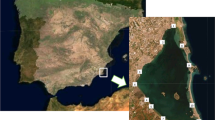Abstract
Selected polychlorinated dibenzo-p-dioxins (PCDDs) and dibenzofurans (PCDFs) were detected by gas-chromatography coupled to triple quadrupole mass spectrometry (GC-QqQ-MS/MS) in marine sediments collected in central Italy. Total PCDD/Fs concentrations ranged from 11.58 to 193.29 pg/g d.w., with PCDFs as the major contributors in most cases. The congener profiles were characterized by high OCDD (70.7 %–91.4 %). The PCDD/Fs values are within or close to the Environmental Canada sediment reference values (0.85 pg TEQ/g d.w.). GC-QqQ-MS/MS can be a suitable alternative to standard methods for PCDD/Fs determination in environmental samples. The measured PCDD/Fs amounts could be considered as a basis for future monitoring programs.
Similar content being viewed by others
References
Berg MV, Birnbaum L, Bosveld ATC, Brunstrom B, Cook P, Feeley M et al (1998) Toxic equivalency factors (TEFs) for PCBs, PCDDs, PCDFs for humans and wildlife. Environ Health Perspect 106:775–792
Chi KH, Luo S, Hsu SC, Kao SJ, Tsai YJ, Chang MB (2009) Historical trends of dioxin-like compounds and heavy metals in sediments buried in a reservoir in central Taiwan. Chemosphere 76:286–292
Danis B, Debacker V, Miranda CT, Dubois P (2006) Levels and effects of PCDD/Fs and co-PCBs in sediments, mussels, and sea stars of the intertidal zone in the southern North Sea and the English Channel. Ecotoxicol Environ Saf 65:188–200
Frignani M, Bellucci LG, Favotto M, Albertazzi S (2005) Pollution historical trends as recorded by sediments at selected sites of the Venice Lagoon. Environ Int 31:1011–1022
Jin GZ, Lee SJ, Park H, Lee JE, Shin SK, Chang YS (2009) Characteristics and emission factors of PCDD/Fs in various industrial wastes in South Korea. Chemosphere 75:1226–1231
Kiviranta H, Ovaskainen ML, Vartiainen T (2004) Market basket study on dietary intake of PCDD/Fs, PCBs, and PBDEs in Finland. Environ Int 30:923–932
Mohammed C, Orazio P, Peterman K, Echols K, Feltz A, Manoo D et al (2009) Polychlorinated dibenzo-p-dioxin (PCDDs) and polychlorinated dibenzofurans (PCDFs) in harbor sediments from Sea Lots, Port-of-Spain, Trinidad and Tobago. Mar Pollut Bull 58:928–934
Okumura Y, Yamashita Y, Kohno Y, Nagasaka H (2004) Historical trends of PCDD/Fs and CO-PCBs in a sediment core collected in Sendai Bay, Japan. Water Res 38:3511–3522
Pan J, Yang Y, Geng C, Yeung LW, Cao X, Dai T (2010) Polychlorinated biphenyls, polychlorinated dibenzo-p-dioxins and dibenzofurans in marine and lacustrine sediments from the Shandong Peninsula, China. J Hazard Mater 176:274–279
Reiner EJ (2010) The analysis of dioxins and related compounds. Mass Spectrom Rev 29:526–559
United Nations Environment Programme (2001) Stockholm Convention on Persistent Organic Pollutants (POPs) United Nations Environment Programme (UNEP) Chemicals. http://www.chem.unep.ch/pops/. Accessed 13 June 2012
US Environmental Protection Agency (1994) Tetra- through octa-chlorinated dioxins and furans by isotope dilution HRGC/HRMS method 1613
Van den Berg M, Birnbaum LS, Denison M, De Vito M, Farland W, Feeley M, Fiedler H, Hakansson H, Hanberg A, Haws L, Rose M, Safe S, Schrenk D, Tohyama C, Tritscher A, Tuomisto J, Tysklind M, Walker N, Peterson RE (2006) The 2005 World Health Organization reevaluation of human and Mammalian toxic equivalency factors for dioxins and dioxin-like compounds. Toxicol Sci 93:223–241
Yao Y, Masunaga S, Takada H, Nakanishi J (2002) Identification of polychlorinated dibenzo-p-dioxin, dibenzofuran, and coplanar polychlorinated biphenyl sources in Tokyo Bay, Japan. Environ Toxicol Chem 21:991–998
Author information
Authors and Affiliations
Corresponding author
Rights and permissions
About this article
Cite this article
Guidotti, M., Protano, C., Dominici, C. et al. Determination of Selected Polychlorinated Dibenzo-p-dioxins/Furans in Marine Sediments by the Application of Gas-Chromatography-Triple Quadrupole Mass Spectrometry. Bull Environ Contam Toxicol 90, 525–530 (2013). https://doi.org/10.1007/s00128-012-0956-5
Received:
Accepted:
Published:
Issue Date:
DOI: https://doi.org/10.1007/s00128-012-0956-5




